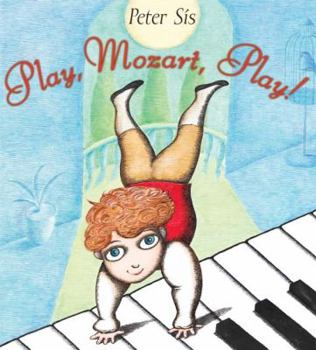Play, Mozart, Play!
Select Format
Select Condition 
Book Overview
Listen. A little boy named Wolfgang Amadeus Mozart is playing the piano. Look. He is playing backward! He is playing blindfolded! Imagine. What must his life be like? Play, Mozart, play! Acclaimed... This description may be from another edition of this product.
Format:Hardcover
Language:English
ISBN:0061121819
ISBN13:9780061121814
Release Date:January 2006
Publisher:Greenwillow Books
Length:32 Pages
Weight:0.99 lbs.
Dimensions:0.4" x 9.3" x 10.2"
Age Range:3 years and up
Grade Range:Preschool and higher
Customer Reviews
2 ratings
4 1/2* Brilliantly Illustrated, but Story Plays it Safe
Published by Thriftbooks.com User , 18 years ago
The excellence of Peter SIs' illustrations is evident even from the frontispiece (that page before the title page). The line drawings of diverse musical instruments against dappled watercolor backgrounds, are simple, elegant, and completely caught my eye. The rest of the book fulfills this initial promise, as Sis displays a dazzling variety of technique and style: Close-ups and silhouettes, various backgrounds for the text (faux parchment paper, musical scores, patterned paper), watermarks and age spots, and period drawings of European capitals--like the ones you see on old Porcelain teacups and plates. The pictures consistently amaze. Unfortunately, Sis' kid bio of Mozart takes the easy way out after an imaginative beginning. Mozart was a" famous composer and a child genius. His father turned him into a child sensation." Yet, as the story progresses, it becomes clear that his father's hand is on the tyrannical side. More on that later... Mozart plays for "kings and princes and dukes." Sis dispalys these royal appearnces as decorations on six ornate fans (with fan-holding courtiers placing the fans in historical context). Moreover, Mozart was apparently the Jimi Hendrix of his era, playing blindfolded, backwards, with covered keys, and while standing on furniture (there's no mention of whether he played with his teeth or burned his pianos). This light tone shifts abruptly, however, as the silhouetted figure of his stern father points a commanding finger at him, We learn of Mozart's dilemma: "...Mozart did not play with other children, because his father made him practice all the time." We view young Mozart from above, as we hear the commands from Dad: "Play, Mozart, Play!" Mozart escapes into his music amid this fevered atmosphere, and things in the piano room morph into animated, slightly bizarre objects with faces: An airborne clock, a melting candlestick, winged potatoes, a whale spouting notes from his blow hole. The slightly bizarre "Alice in Wonderland" like images are even larger on the next 2-page spread, commanding an entire stage, with Mozart playing a flute (no doubt a reference to his Opera, "The Magic Flute"). In the only reference to his father's regimen, Sis has him asking, "Wolfgang, are you playing," and Mozart scampers back to his piano, looking like he's been caught with his hands in the cookie jar, not on the keyboard. The objects in the room return to normal, and they're in an austere black and white. They appear defeated. This is where Sis lets us down. He could have continued the father/son conflict, the battle between ambition and playing for fun and emotional release. This theme was explored in the great "The 5,000 FIngers of Dr. T.," the film that revealed the double-edged sword of striving for musical perfection. However, having led us to this point, Sis abandons it, showing us only that Mozart continued to play day and night, in his imagination, in his dreams, and throughout his life. In the biggest betrayal,
Play, Mozart, Play
Published by Thriftbooks.com User , 19 years ago
Beautifully illustrated with simple information about Mozart's early performance life. Easy for pre-schoolers to understand and appreciate. Sure to inspire budding appreciation of classical music.






